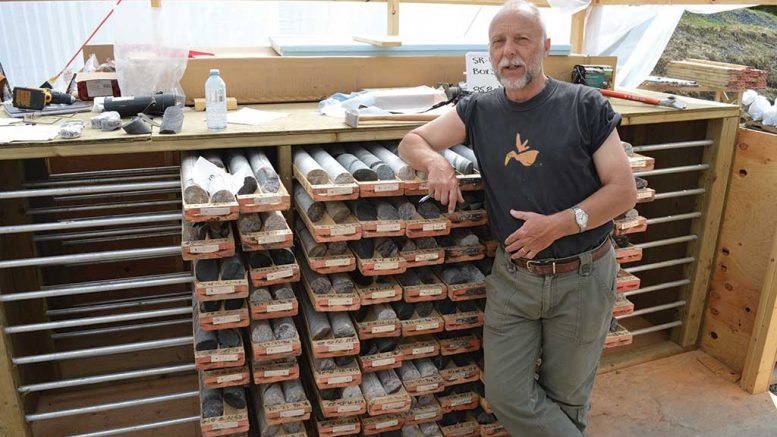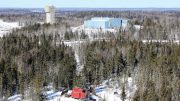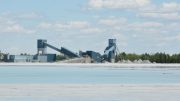A new lithium pegmatite Avalon Advanced Materials (TSX: AVL; US-OTC: AVLNF) is naming Snowbank has been found 4 km northwest of the company’s main Separation Rapids lithium deposit, near Kenora, Ontario.
Like the Separation Rapids deposit, Snowbank’s lithium occurs mostly in petalite, a mineral that occurs as large crystals up to 15 centimetres in diameter.
Individual channel samples at Snowbank have returned assays of up to 2.51% lithium oxide (Li2O) over 1.1 metres, which the company says shows that petalite makes up 50% of the mineral content in the rock sample. Visible petalite occurs for 100 metres.
The Snowbank pegmatite zone runs up to nine metres wide, but pinches and swells, with some sections splitting into smaller, parallel dikes that measure from one to three metres wide, for an average width of 6 metres over the 100-metre-long exposure.
Snowbank’s individual dikes exhibit classic pegmatite zoning, with coarse petalite, potassium feldspar, albite and quartz, flanked by narrow albitic border and wall zones.
Three channel samples collected from the petalite mineralized sections of the main pegmatite zone averaged 1.40% lithium oxide, while three other parallel dikes, also sampled, locally host similar mineralization over narrower widths.

The surface of Avalon Advanced Materials’ Separation Rapids lithium deposit in northern Ontario. Credit: Avalon Advanced Materials.
Highlights include lithium values of 1.53% Li2O over 2.6 metres in channel 1A; 1.61% Li2O over 2.3 metres in channel 2B; and 1.07% Li2O over 2.9 metres in channel 4A. The three channels are distributed over a strike length of just over 30 metres, with spacing averaging 10 metres in one discrete, pegmatite dike.
Avalon plans to drill Snowbank during late 2019.
The Snowbank discovery follows an August PEA on Avalon’s main Separation Rapids project, 70 km north of Kenora.
The updated PEA is smaller in scope than the previous PEA completed in 2016, and focuses on early production of lithium mineral concentrates, with potential for expansion into producing the battery materials lithium carbonate and lithium hydroxide.
The study envisioned a plant throughput rate of 475,000 tonnes per year compared to the 950,000-tonne-per-year rate from the 2016 PEA. This will result in a 20-year operating life, based on the deposit’s known resources.
The PEA outlined annual production of 71,500 tonnes of petalite concentrate; 11,800 tonnes of lepidolite concentrate (both for 18.5 years); and, starting in year six, 100,000 tonnes of feldspar (through to year 20).
About $77.7 million in upfront capital would help build the project, with another $13.7 million planned for the feldspar circuit in years five and six (or after paying back the initial capital).
The PEA estimated average annual revenue of $90 million, compared with average annual costs of $60 million, resulting in a post-tax net present value at an 8% discount rate of $102 million and 22.7% after-tax internal rate of return.
Separation Rapids remains open at depth and has measured and indicated resources of 8.41 million tonnes averaging 1.41% Li2O and inferred resources of 1.79 million tonnes of 1.35% Li2O.
Avalon notes that while much of the demand and long-term growth prospects for lithium supply revolve around the rechargeable battery industry, lithium is also a critical ingredient in many other things — such as glass and ceramics — which now have to compete for supply with battery makers.
Petalite, the primary lithium mineral at Separation Rapids, is suitable for many of these applications as an industrial mineral because of its purity and unique crystal structure, Avalon says, adding that recent test work has “demonstrated that a high-purity petalite product can be produced from the Separation Rapids resource.

The Big Whopper petalite deposit at Avalon Advanced Materials’ Separation Rapids lithium project north of Kenora, Ontario. Credit: Avalon Advanced Materials.
“This product, called ‘super petalite,’ has attracted considerable interest from consumers in the glass and ceramics industry, leading to the conclusion that petalite concentrates should be the initial focus of production from Separation Rapids,” the company said in its August news release. “Discussions toward concluding off-take agreements with major consumers of this product in the glass industry are now at an advanced stage.”
Petalite production will be supplemented with the production of a second lithium mineral concentrate: lepidolite. Lepidolite is a lithium mineral that is in growing demand for conversion to lithium carbonate, and Avalon has a preliminary off-take agreement with Lepidico, an Australian company in Perth, that plans to develop a lithium carbonate demonstration production facility in Sudbury, Ontario.
But Avalon isn’t ruling out converting petalite concentrate into lithium hydroxide for the battery and energy-storage industries. That scenario, presented in its 2016 PEA, is an opportunity as the company delineates more resources, it says.
“Development into these markets would start with the addition of a pilot-scale lithium hydroxide production circuit at the mine site to produce trial quantities of the battery material product, and prove the innovative process flowsheet developed by the company in 2016,” the company says.
Avalon’s next step is to start a short pilot program to finalize reagent recycling and water treatment processes and complete a feasibility study. That work will likely take place later this year, after the company concludes off-take agreements and secures more financing.
Drilling is also planned to convert more inferred resources into the measured and indicated category, and to explore for new lithium pegmatites, particularly on the western extension of its property, where it has found new petalite occurrences, including the Glitter pegmatite, 2 km from Snowbank.
Avalon plans to start permitting later this year, once it has engineering data and project financing. Avalon is also working with Hydro One to figure out the optimal route to deliver hydroelectric power to the site from one of the nearby dams on the English River.
The claims are in the traditional territory of the Wabaseemoong Independent Nation of Whitedog, Ontario.






Be the first to comment on "Avalon discovers lithium pegmatite"